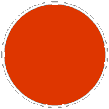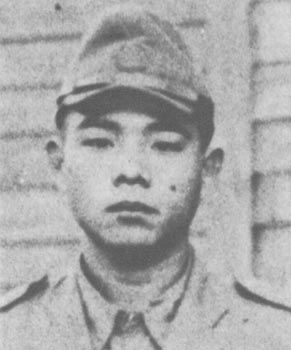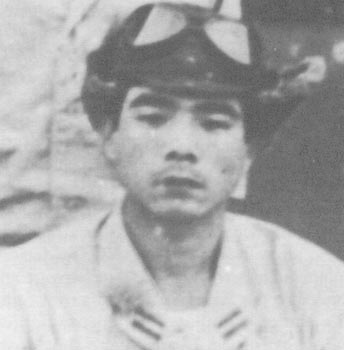Japan

Ensign Masa-ichi Kondo
Japan

Ensign Masa-ichi Kondo

Kondo was born in Ehime Prefecture on 5 November 1917.
He graduated from the 27th Pilot Training Class in July 1935 and was posted to the Omura Kokutai.
At the start of the China Incident he served on board the aircraft carrier Ryujo, which was equipped with Nakajima A2N fighters.
At the outbreak of the China Incident the light aircraft carrier Hosho was posted together with the carrier Ryujo to the 1st Carrier Division of the 3rd Fleet, leaving the port of Sasebo on 12 August. Arriving in the Ma-an-shan Islands area, they started supporting land operations beginning on 16 August. During this period, both Kaga and Ryujo groups had opportunity to engage in aerial battles.
At 08:40 on 23 August four aircraft from Ryujo under the command of Lieutenant (junior grade) Minoru Suzuki discovered a mixed force of twenty-seven enemy aircraft, including Boeing 281s, while they were scouting over Pao-Shan. The units engaged in battle and a total of nine (or ten) enemy aircraft were downed, including those downed by three aircraft of Suzuki’s force. Two of the Chinese fighters were claimed by Suzuki’s number two wingman, PO1c Kondo. The Japanese fighters returned without losses.
The China Area Fleet commander in chief issued a letter of commendation in connection with this battle.
The Japanese fighters had engaged a mixed force of nineteen aircraft under the command of Captain Huang Kuang-Han, Squadron Leader of the 22nd PS, 4th PG. During the combat the Chinese lost Boeing 281 no.1702 flown by flight leader Gin Jia-Zhu of the 17th PS. Boeing 281 no.1704 flown by Ma Kuo-Lien was hit 23 times before making a forced-landing and turning over. Squadron Leader Captain Liu Chui-Kang of the 24th PS, 5th PG claimed an A4N south-west of Shanghai while flying Curtiss Hawk III no. 2401.
Hosho and Ryujo proceeded south from Sasebo on 5 September, and starting 21 September, conducted several attacks on enemy bases in the vicinity of Canton.
Kondo took part in the attack on Canton on 21 September.
He was transferred to Kaga during 1938 and continued to take part in the attacks on Canton.
In June 1938, he was transferred to the 15th Kokutai and in November, he returned to Japan when the Kokutai was disbanded.
In October 1939, he was transferred to the 12th Kokutai.
He took part in the attacks on Liuchow on 30 December and on Kweilin on 10 January 1940.
In these operations Kondo showed battle successes.
Totally, Kondo claimed six victories over China.
Once the Pacific War started, in July he was ordered on board the Zuiho.
On 26 October, he participated in the Battle of Santa Cruz. Nine aircraft from the Zuiho carrier fighter daitai led by the CO Lieutenant Saneyasu Hidaka were used for escorting the first attack wave on its way to attack American carriers.
While in the air the Japanese fighters passed American torpedo aircraft and their fighter escort that had come from the Enterprise and were on their way to attack Japanese aircraft carriers. Lieutenant Hidaka decided independently to leave the attack group and challenge the American aircraft to a fight. In a matter of minutes, six enemy fighters and eight torpedo aircraft were claimed shot down. PO1c Kondo of the 3rd shotai claimed three of the enemy aircraft.
At the same time, however, during this air battle, the Hidaka unit lost its bearings and each shotai was left to find it own way back. Four aircraft (including the whole 2nd shotai) flown by PO3c Shizuta Takagi (1st shotai), Lieutenant (junior grade) Shu-ichi Utsumi (2nd shotai), PO1c Masao Kawasaki (2nd shotai) and PO3c Zenpei Matsumoto (2nd shotai) failed to return.
In November Kondo was transferred to the Junyo and participated in the third Battle of the Solomons (the Naval Battle of Guadalcanal).
He was engaged in supporting transports destined for Wewak, in the Guadalcanal evacuation operation and in the “I”-go operation.

In May 1943, Kondo returned to Japan to participate in the effort to relieve Attu Island.
On 2 July, the Junyo fighter daitai was ordered to proceed to Buin and was thrust into the offensive and defensive operations around Rendova (Solomons).
On 15 August, Kondo sortied in support of carrier bombers en route to attack Vella Lavella. After he had shot down one aircraft he was severely wounded in his left leg and he was forced to manoeuvre his aircraft using his right leg only. He managed to return to Buin and was hospitalised.
Kondo was sent back to Japan and entered a hospital for treatment for a period of one year and three months. He then returned to Kokutai 203.
Kondo greeted the end of the war without any further combat action.
Kondo ended the war with 2 biplane victories and a total of 13.
Claims:
| Kill no. | Date | Time | Number | Type | Result | Plane type | Serial no. | Locality | Unit |
| 1937 | |||||||||
| 1 | 23/08/37 | 08:40- | 1 | Boeing 281 (a) | Destroyed | Nakajima A2N | Pao-Shan | Ryujo FS | |
| 2 | 23/08/37 | 08:40- | 1 | Boeing 281 (a) | Destroyed | Nakajima A2N | Pao-Shan | Ryujo FS | |
| 1942 | |||||||||
| ? | 26/10/42 | 1 | Enemy aircraft | Destroyed | Mitsubishi A6M | Santa Cruz | Zuiho FS | ||
| ? | 26/10/42 | 1 | Enemy aircraft | Destroyed | Mitsubishi A6M | Santa Cruz | Zuiho FS | ||
| ? | 26/10/42 | 1 | Enemy aircraft | Destroyed | Mitsubishi A6M | Santa Cruz | Zuiho FS | ||
| 1943 | |||||||||
| 13 | 15/08/43 | 1 | Enemy aircraft | Destroyed | Mitsubishi A6M | Vella Lavella | Junyo FS |
Biplane victories: 2 destroyed.
TOTAL: 13 destroyed.
(a) Boeing 281 no.1702 flown by flight leader Gin Jia-Zhu of the 17th PS shot down. Boeing 281 no.1704 flown by Ma Kuo-Lien of the 17th PS hit 23 times before making a forced-landing and turning over.
Sources:
Japanese Naval Aces and Fighter Units in World War II - Ikuhiko Hata and Yasuho Izawa, translated by Don Cyril Gorham, 1989 United States Naval Institute, Annapolis, ISBN 0-87021-315-6
Additional information kindly provided by Edward Chan.


